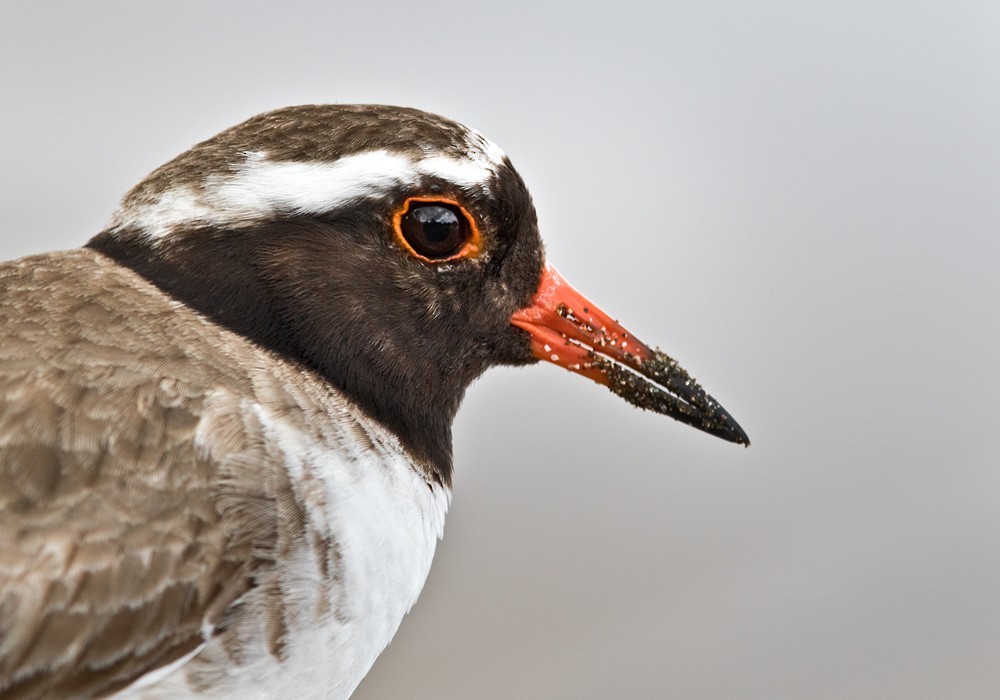Shore Dotterel
A species of Hooded and Shore Plovers, Also known as Tuturuatu Scientific name : Thinornis novaeseelandiae Genus : Hooded and Shore Plovers
Shore Dotterel, A species of Hooded and Shore Plovers
Also known as:
Tuturuatu
Botanical name: Thinornis novaeseelandiae
Genus: Hooded and Shore Plovers
Content
Description General Info
 Photo By Lars Petersson
Photo By Lars Petersson Description
Thinornis novaeseelandiae is brown above and white below, with a black (male) or brown (female) mask. There is a distinctive white strip circling its head below its brown skullcap. Its legs and dark-tipped bill are orange, brighter in males. 
Size
20 cm
Nest Placement
Ground
Feeding Habits
Shore Dotterel consumes small crustaceans, spiders, gastropods, bivalves, insects, Hemiptera, caterpillars, and larvae. Utilizes foot-trembling and beak-probing to forage, adjusts feeding times to low tide, and is active day and night. Sometimes forages in flocks during the non-breeding season.
Habitat
The habitat of shore Dotterel is characterized by coastal environments, predominantly rocky shores with tidal pools and boulder-laden beaches. They are often found in areas with marine invertebrate growth like barnacles and algae. Shore Dotterel can also settle in adjacent salt-meadows with specialized salt-tolerant vegetation. While they formerly inhabited estuarine mudflats, they now typically breed in areas strewn with boulders or inland salt-meadows with robust herbaceous plant growth.
Dite type
Aquatic invertebrate eater
General Info
Feeding Habits
Bird food type
Distribution Area
Although this species was historically found only on the New Zealand coast, subfossil shore plover bones have been recovered from roosts of the extinct laughing owl near rivers many kilometres inland. Cook's second expedition collected them from opposite ends of the South Island, in Fiordland and the Marlborough Sounds. There are 19th century reports of shore plovers from the South Island and several parts of the North Island, but by the 1870s they had vanished from the mainland, surviving only on the Chatham Islands. Introduced predators such as feral cats and Norway rats were the main culprits. 
Species Status
Shore plovers are endangered, with a world population of around 200 birds. The species survived on only one island, Rangatira, in the Chatham Islands, from where it has since been introduced to other offshore islands, such as Mangere Island in the Chathams, Mana Island near Wellington and Motutapu near Auckland. The world population was roughly 70 breeding pairs in 1937 and their habitat was declared a reserve in 1954. The population fluctuated in the 1980s, with only 40 breeding pairs in 1982, rising to 80 pairs in 1987 and a high of 94 pairs in 2010. A second wild population of about 20 birds was discovered in 1999 living on Western Reef off Chatham Island, but it gradually declined, and the last bird was taken into captivity in 2003. As of 2016, the wild population comprised 66 breeding pairs, 56 of them in the Chatham Islands. DOC has a stated goal of increasing the population to 250 in five different habitats. DOC moved a number of captive-reared juveniles to Mana Island, off Wellington's western coast, between March and May 2007. They bred within months of their arrival, and in February 2008 twenty more were translocated. From a high of 87 individuals, the population was reduced to just 10 from the effects of a single Norway rat. Birds had also been translocated since 2000 to Waikawa (Portland Island), a privately owned island off the Mahia Peninsula in Hawke's Bay. In 2012, the population on Waikawa was discovered to have crashed by 75% to just 20 birds, apparently due to predation by a Norway rat. Twelve eggs were rescued for translocation to Mana Island. A total of 42 captive-bred shore plovers were released onto Motutapu Island in 2012 in the hope they would become established there and on other pest-free islands in the Hauraki Gulf. The birds repeatedly flew away, and only five were still present in 2015 when nineteen more were released. Motutapu had its mammalian pests removed in 2010, and the breeding population there increased from one pair in 2015 to three pairs in 2016. These birds are currently the most accessible to the public. Six juveniles were released into the wild in 2018. Four additional juveniles were released in February 2019 with a further 21 due to be released on 25 March, having been bred at the Pūkaha National Wildlife Centre. Five more juvenile birds were transported from a captive breeding program in Christchurch to Mana Island in April 2020 during the COVID‑19 lockdown. 

 Photo By Lars Petersson
Photo By Lars Petersson Scientific Classification
Phylum
Chordates Class
Birds Order
Shorebirds Family
Plovers Genus
Hooded and Shore Plovers Species
Shore Dotterel